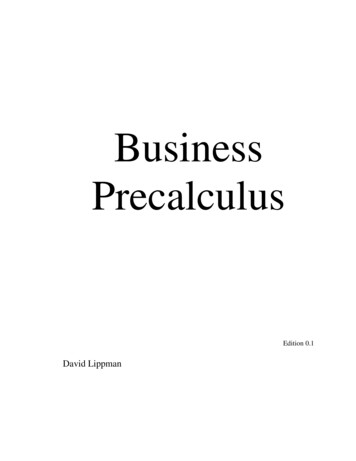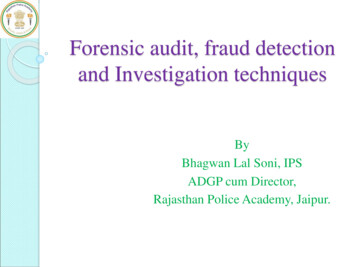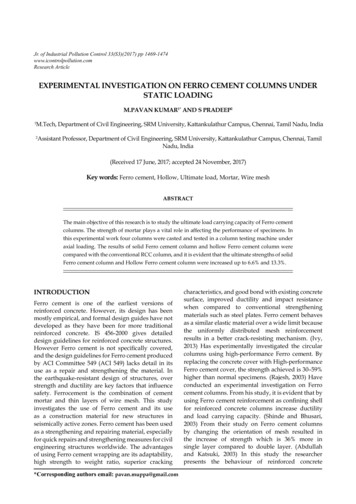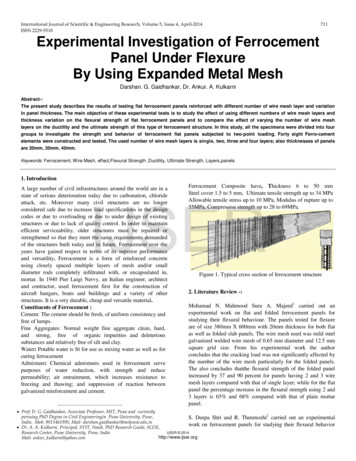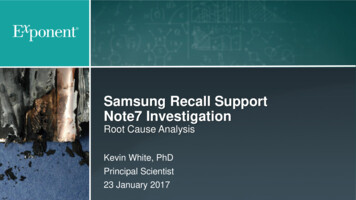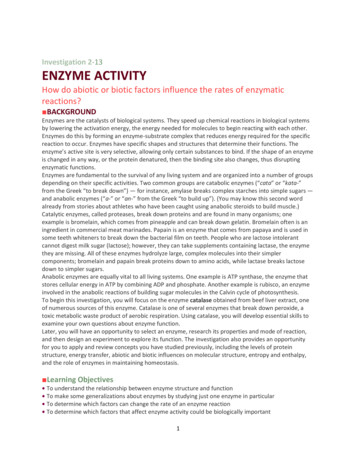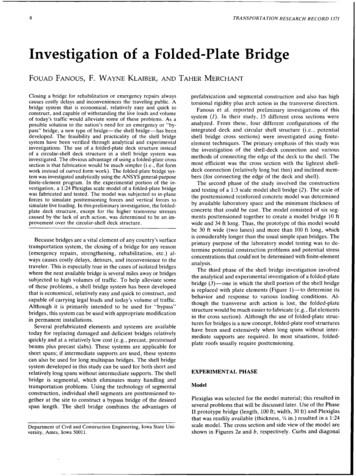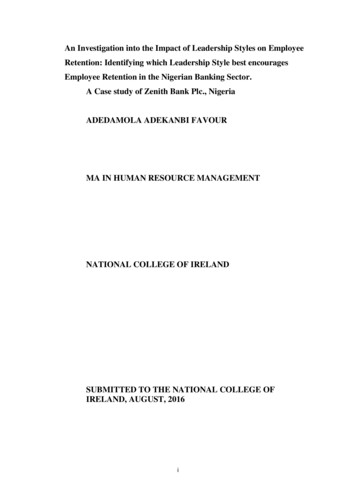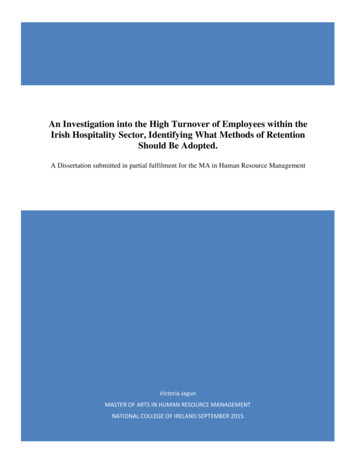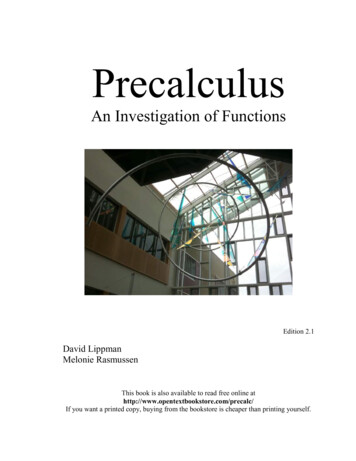
Transcription
PrecalculusAn Investigation of FunctionsEdition 2.1David LippmanMelonie RasmussenThis book is also available to read free online athttp://www.opentextbookstore.com/precalc/If you want a printed copy, buying from the bookstore is cheaper than printing yourself.
iiCopyright 2018 David Lippman and Melonie RasmussenThis text is licensed under a Creative Commons Attribution-Share Alike 3.0 UnitedStates License.To view a copy of this license, visit http://creativecommons.org/licenses/by-sa/3.0/us/ or send a letter toCreative Commons, 171 Second Street, Suite 300, San Francisco, California, 94105, USA.You are free:to Share — to copy, distribute, display, and perform the workto Remix — to make derivative worksUnder the following conditions:Attribution. You must attribute the work in the manner specified by the author or licensor (but not inany way that suggests that they endorse you or your use of the work).Share Alike. If you alter, transform, or build upon this work, you may distribute the resulting workonly under the same, similar or a compatible license.With the understanding that:Waiver. Any of the above conditions can be waived if you get permission from the copyright holder.Other Rights. In no way are any of the following rights affected by the license: Your fair dealing or fair use rights; Apart from the remix rights granted under this license, the author's moral rights; Rights other persons may have either in the work itself or in how the work is used, such aspublicity or privacy rights. Notice — For any reuse or distribution, you must make clear to others the license terms ofthis work. The best way to do this is with a link to this web /us/In addition to these rights, we give explicit permission to remix small portions of thisbook (less than 10% cumulative) into works that are CC-BY, CC-BY-SA-NC, or GFDLlicensed.Selected exercises were remixed from Precalculus by D.H. Collingwood and K.D.Prince, originally licensed under the GNU Free Document License, with permission fromthe authors. These are marked in the book as [UW].Portions of chapter 3 were remixed from College Algebra by Carl Stitz and Jeff Zeager,originally licensed under a Creative Commons Attribution ShareAlike Non-Commerciallicense, used with permission from the authors.Portions of chapter 9 were remixed from work by Lara Michaels, and contains contentremixed from Precalculus by OpenStax, originally licensed under a Creative CommonsAttribution license. The original version is available online for free at OpenStax.org.Cover photos by Ralph Morasch and David Lippman, of artwork by John Rogers.Lituus, 2010. Dichromatic glass and aluminum.Washington State Arts Commission in partnership with Pierce College
iAbout the AuthorsDavid Lippman received his master’s degreein mathematics from Western WashingtonUniversity and has been teaching at PierceCollege since Fall 2000.Melonie Rasmussen also received hermaster’s degree in mathematics fromWestern Washington University and hasbeen teaching at Pierce College since Fall2002. Prior to this Melonie taught for thePuyallup School district for 6 years after receiving her teaching credentials from PacificLutheran University.We have both been long time advocates of open learning, open materials, and basicallyany idea that will reduce the cost of education for students. It started by supporting thecollege’s calculator rental program, and running a book loan scholarship program.Eventually the frustration with the escalating costs of commercial text books and theonline homework systems that charged for access led them to take action.First, David developed IMathAS, open source online math homework software that runsWAMAP.org and MyOpenMath.com. Through this platform, we became integral partsof a vibrant sharing and learning community of teachers from around Washington Statethat support and contribute to WAMAP. Our pioneering efforts, supported by dozens ofother dedicated faculty and financial support from the WA-SBCTC, have led to a systemused by thousands of students every quarter, saving hundreds of thousands of dollars overcomparable commercial offerings.David continued further and wrote his first open textbook, Math in Society, a math forliberal arts majors book, after being frustrated by students having to pay 100 for atextbook for a terminal course. Together, frustrated by both cost and the style ofcommercial texts, we began writing PreCalculus: An Investigation of Functions in 2010.Since then, David has contributed to several other open texts.
iiAcknowledgementsWe would like to thank the following for their generous support and feedback. The community of WAMAP users and developers for creating a majority of thehomework content used in our online homework sets. Pierce College students in our Fall 2010 - Summer 2011 Math 141 and Math 142classes for helping correct typos, identifying videos related to the homework, andbeing our willing test subjects. The Open Course Library Project for providing the support needed to produce afull course package for these courses. Mike Kenyon, Chris Willett, Tophe Anderson, and Vauhn Foster-Grahler forreviewing the course and giving feedback and suggestions. Our Pierce College colleagues for providing their suggestions. Tophe Anderson, James Gray, and Lawrence Morales for their feedback andsuggestions in content and examples. Jeff Eldridge for extensive proofreading and suggestions for clarification. James Sousa for developing videos associated with the online homework. Kevin Dimond for his work on indexing the book and creating PowerPoint slides. Faculty at Green River Community College and the Maricopa College District fortheir feedback and suggestions. Lara Michaels for contributing the basis for a conics chapter. The dozens of instructors who have sent us typos or suggestions over the years.
iiiPrefaceOver the years, when reviewing books we found that many had been mainstreamed bythe publishers in an effort to appeal to everyone, leaving them with very littlecharacter. There were only a handful of books that had the conceptual and applicationdriven focus we liked, and most of those were lacking in other aspects we cared about,like providing students sufficient examples and practice of basic skills. The largestfrustration, however, was the never ending escalation of cost and being forced into neweditions every three years. We began researching open textbooks, however the ability forthose books to be adapted, remixed, or printed were often limited by the types of licenses,or didn’t approach the material the way we wanted.This book is available online for free, in both Word and PDF format. You are free tochange the wording, add materials and sections or take them away. We welcomefeedback, comments and suggestions for future development atprecalc@opentextbookstore.com. Additionally, if you add a section, chapter or problems,we would love to hear from you and possibly add your materials so everyone can benefit.In writing this book, our focus was on the story of functions. We begin with functionnotation, a basic toolkit of functions, and the basic operation with functions: compositionand transformation. Building from these basic functions, as each new family of functionsis introduced we explore the important features of the function: its graph, domain andrange, intercepts, and asymptotes. The exploration then moves to evaluating and solvingequations involving the function, finding inverses, and culminates with modeling usingthe function.The "rule of four" is integrated throughout - looking at the functions verbally,graphically, numerically, as well as algebraically. We feel that using the “rule of four”gives students the tools they need to approach new problems from various angles. Oftenthe “story problems of life” do not always come packaged in a neat equation. Being ableto think critically, see the parts and build a table or graph a trend, helps us change thewords into meaningful and measurable functions that model the world around us.There is nothing we hate more than a chapter on exponential equations that begins"Exponential functions are functions that have the form f(x) ax." As each family offunctions is introduced, we motivate the topic by looking at how the function arises fromlife scenarios or from modeling. Also, we feel it is important that precalculus be thebridge in level of thinking between algebra and calculus. In algebra, it is common to seenumerous examples with very similar homework exercises, encouraging the studentto mimic the examples. Precalculus provides a link that takes students from the basicplug & chug of formulaic calculations towards building an understanding that equationsand formulas have deeper meaning and purpose. While you will find examples andsimilar exercises for the basic skills in this book, you will also find examples of multistepproblem solving along with exercises in multistep problem solving. Often times theseexercises will not exactly mimic the exercises, forcing the students to employ theircritical thinking skills and apply the skills they've learned to new situations. By
ivdeveloping students’ critical thinking and problem solving skills this course preparesstudents for the rigors of Calculus.While we followed a fairly standard ordering of material in the first half of the book, wetook some liberties in the trig portion of the book. It is our opinion that there is no needto separate unit circle trig from triangle trig, and instead integrated them in the firstchapter. Identities are introduced in the first chapter, and revisited throughout. Likewise,solving is introduced in the second chapter and revisited more extensively in the thirdchapter. As with the first part of the book, an emphasis is placed on motivating theconcepts and on modeling and interpretation.About the Second EditionAbout 4 years and several minor typo revisions after the original release of this book, westarted contemplating creating a second edition. We didn’t want to change much; we’vealways found it very annoying when new editions change things just for the sake ofmaking it seem different. However, in talking with instructors from around the country,we knew there were a few topics that we had left out that other schools need. We didn’twant to suffer the same “content bloat” that many commercial books do, but we alsowanted to make it easier for more schools to adopt open resources.We put our plans for a new revision on hold after OpenStax started working on aprecalculus book, using the first edition of this text as a base. After the final productcame out, though, we felt it had strayed a bit far from our original vision. We had writtenthis text, not to be an encyclopedic reference text, but to be a concise, easy-to-read,student-friendly approach to precalculus. We valued contextual motivation andconceptual understanding over procedural skills. Our book took, in places, a nontraditional approach to topics and content ordering. Ultimately, we decided to go aheadwith this second edition.The primary changes in the second edition are: New, higher resolution graphs throughout New sections added to Chapter 3:o 3.4 Factor theorem (includes long division of polynomials)o 3.5 Real zeros of polynomials (using rational roots theorem)o 3.6 Complex zeros of polynomials Coverage of oblique asymptotes added to the rational equations section (now 3.7) A new section 8.5 on dot product of vectors A new chapter 9 on conic sectionsThere were many additional refinements, some new examples added, and Try it Nowanswers expanded, but most of the book remains unchanged.
vInstructor ResourcesAs part of the Washington Open Course Library project, we developed a full coursepackage to accompany this text. The course shell was built for the IMathAS onlinehomework platform, and is available for Washington State faculty at www.wamap.organd mirrored for others at www.myopenmath.com. It contains: Online homework for each section (algorithmically generated, free response),most with video help associated.Video lessons for each section. The videos were mostly created and selected byJames Sousa, of Mathispower4u.A selection of printable class worksheets, activities, and handoutsSupport materials for an example course (does not include all sections):o Suggested syllabus and Day by day course guideo Instructor guide with lecture outlines and exampleso Discussion forumso Diagnostic reviewo Chapter review problemso Sample quizzes and sample chapter examsThe course shell was designed to follow Quality Matters (QM) guidelines, but has not yetbeen formally reviewed.Getting StartedTo get started using this textbook and the online supplementary materials, Request an instructor account on WAMAP (in Washington) or MyOpenMath(outside Washington). Review the table of contents of the text, and compare it to your course outcomesor student learning objectives. Determine which sections you will need to cover,and which to omit. If there are topics in your outcomes that are not in the text,explore other sources like the Stitz/Zeager Precalc or OpenStax Precalc tosupplement from. Also check the book’s website, as we may offer additionalonline-only topics. Once your instructor account is approved, log in, and click Add New Course From the “Use content from a template course”, select “Precalculus –Lippman/Rasmussen 2nd Ed”. Note that you might also see two half-booktemplates, one covering chapters 1 – 4, and the other covering chapters 5 – 9. Once you have copied the course, go through and remove any sections you don’tneed for your course. Refer to the Training Course Quickstart videos inMyOpenMath and WAMAP for more details on how to make those changes.
viHow To Be Successful In This CourseThis is not a high school math course, although for some of you the content may seemfamiliar. There are key differences to what you will learn here, how quic
David continued further and wrote his first open textbook, Math in Society, a math for liberal arts majors book, after being frustrated by students having to pay 100 for a textbook for a terminal course. Together, frustrated by both cost and the style of commercial texts, we began writing PreCalculus: An Investigation of Functions in 2010. Since then, David has contributed to several other .
